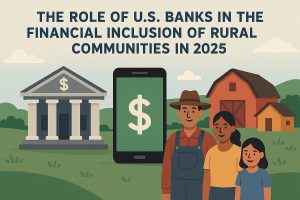Moving to the United States brings plenty of opportunities, but it also comes with challenges, especially when it comes to managing finances. Whether you’re an immigrant planning to settle down or a foreigner staying for an extended period, having a US bank account is essential. It allows you to receive payments, pay bills, and build a financial footprint in the country.
However, without a Social Security Number (SSN) or a permanent address, the process can seem overwhelming. Fortunately, many banks offer solutions tailored to newcomers, making it possible to open an account with the right documents and approach. Let’s dive into the essential steps and tips for opening a bank account in the US as a non-resident.
Choosing the right bank and account type

Selecting a bank that meets your needs is the first step toward opening an account in the US. Different banks have different requirements for non-residents, so it’s important to research your options. Major national banks like Chase, Bank of America, and Wells Fargo are often more flexible when it comes to serving international clients.
They have experience dealing with foreign applicants and offer services tailored to those without an SSN. On the other hand, smaller regional banks and credit unions may have stricter policies but could provide lower fees and a more personalized experience.
When choosing a bank, consider the type of account you need. A checking account is the most common choice for everyday transactions, including receiving paychecks, making purchases, and paying bills. A savings account, on the other hand, helps build financial stability and earn interest on deposits.
Some banks also offer accounts specifically designed for new immigrants, with features such as lower fees, multilingual support, and easier documentation requirements. Comparing the features, fees, and accessibility of different banks can help you make the best decision.
Online banks are another option worth considering, especially if you don’t have a permanent US address yet. Banks like Chime, Wise, and Revolut allow international applicants to open accounts remotely, often with fewer documentation requirements.
However, they may not offer the full range of services available at traditional banks, such as in-person customer support or physical branches. Evaluating the advantages and disadvantages of each type of bank can help you determine which option aligns with your financial needs and residency status.
Documents and requirements for non-residents
One of the most important aspects of opening a bank account in the US is meeting the documentation requirements. While US citizens typically need only a driver’s license and an SSN, non-residents may be required to provide alternative forms of identification.
Most banks ask for at least two pieces of identification, such as a passport and a secondary document like a foreign government-issued ID or a US visa. If you have an ITIN, which is issued by the IRS for tax purposes, it can serve as an alternative to an SSN at many banks.
Proof of address is another common requirement, and this can be tricky for new arrivals. Some banks accept foreign addresses, while others require a US-based address, which can be verified with a utility bill, lease agreement, or a letter from an employer.
If you don’t have a permanent address yet, using a relative’s or friend’s address (with their permission) can sometimes work as a temporary solution. Additionally, banks may ask for proof of income or employment, such as a job offer letter or pay stubs, but this is not always mandatory.
Certain banks may also require an initial deposit to activate the account. This amount varies widely, with some institutions requiring as little as $25, while others may ask for $100 or more. Checking the minimum deposit requirement beforehand ensures that you’re prepared when you visit the bank.
Tips for a smooth banking experience in the US
Once your account is set up, managing it effectively will help you build a strong financial foundation in the US. One of the first things to do is enroll in online banking and set up mobile banking apps. These tools allow you to monitor transactions, transfer funds, and pay bills easily, even if you’re still adjusting to the US banking system.
Setting up direct deposit for your paycheck (if applicable) ensures that you receive payments smoothly without needing to cash checks or visit a branch frequently. Understanding bank fees is also essential, as US banks often charge maintenance fees, ATM withdrawal fees, and foreign transaction fees.
Some banks waive these fees if you maintain a minimum balance or set up direct deposits. Reading the terms carefully and asking about fee waivers can help you avoid unnecessary charges. Additionally, using in-network ATMs or online payment methods can reduce the costs associated with banking transactions.
Building a credit history is another crucial aspect of financial success in the US. While a basic checking or savings account does not impact your credit score, opening a secured credit card or applying for a credit-builder loan can help establish your credit profile. Many banks offer credit-building options for newcomers, and responsible usage can make it easier to qualify for loans, mortgages, and better financial opportunities in the future.
If you plan to stay in the US long-term, applying for an ITIN or eventually obtaining an SSN can expand your banking options. These numbers make it easier to apply for credit cards, loans, and other financial products that require a US-based credit history.
Staying informed about tax obligations is also important, as certain accounts may require reporting to the IRS, even if you are not a permanent resident. Opening a bank account in the US as an immigrant or foreigner may seem complicated, but with the right preparation and knowledge, it can be a smooth and straightforward process.
Choosing the right bank, gathering the necessary documents, and understanding the available services will help you integrate into the US financial system successfully. By taking these steps, you’ll not only secure a safe place for your money but also pave the way for future financial stability and growth in your new home.






